In this article we will be looking at how air cooled chillers work. Air cooled chillers are very common, especially in small to medium size commercial and office type buildings. They are usually located externally, either up on the roof or at ground level. This is because Air Cooled Chillers do not use cooling towers, instead they dump their heat into the ambient air and therefore need access to a lot of fresh air, in order to reject the unwanted heat from the building. Scroll to the bottom to watch the tutorial video on this subject.
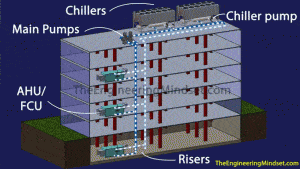
The chillers will produce “chilled water” which is pumped out around the building to the Air Handling Units (AHU’s) and Fan Coil Units (FCU’s) Which remove the unwanted heat from the building and transfer it into the chilled water loop. The chilled water will enter the AHU’s/FCU’s at around 6°C (42.8°F) and by the time it leaves the heat exchanger within the AHU/FCU it will have risen to around 12°C (53.6°F) and will then make its way back to the Air Cooled Chiller to dump this heat into the atmosphere before repeating the cycle.
The warm return “chilled water” only enters the evaporator where it passes along the outside surface area of the inner tubes, which contain the refrigerant, it then exits at the opposite end having given up its thermal energy. The refrigerant is the only fluid which moves around each of the components of the chiller. It changes its pressure, temperature, enthalpy and entroy as it moves around the machine and transports the unwanted heat away from the evaporator chilled water.
The Air Cooled Chiller has 5 main components.
- The compressor – typically screw, scroll or reciprocating
- The condenser – a bundle of horizontal pipes which contain the hot refrigerant, these are surrounded by a number of thin sheets of metal in the vertical axis. These help distribute heat away from the tubes and into the air which is blown across the tubes and thin sheets of metal.
- Condenser fans – These suck air across the condenser coils, entering from the sides, and then force this air out the top of the unit upwards into the ambient atmosphere.
- Expansion Valve – This expands the refrigerant before it enters the evaporator
- Evaporator – This is where the chilled water is produced and the heat from the warm return “chilled water” is extracted, to be sent to the condenser.
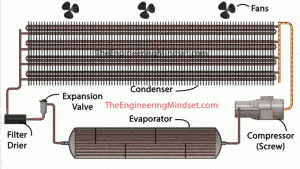
How the refrigerant moves around the chiller
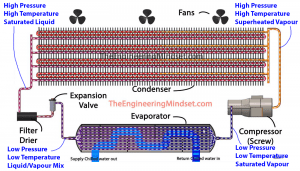
The compressor is the driving force of the refrigerant. The refrigerant first leaves the compressor as a high pressure, high temperature, superheated vapour and then enters the condenser.
When the refrigerant enters into the condenser, it will run along the horizontal pipes and transfer its thermal energy into the ambient air stream which is forced by the fans on top.
As the refrigerant transfers its thermal energy, it begins to condense into a liquid. By the time the refrigerant leaves the condenser, it will be a high pressure, medium temperature, saturated liquid.
Next the refrigerant enters the expansion valve. The expansion valve meters the flow of refrigerant around the system. The most basic type is the thermal expansion valve which controls the flow of refrigerant by measuring the pipe temperature at the evaporator outlet and will adjust the flow rate to keep the temperature within a desired setpoint.
The expansion valve holds back the refrigerant and maintains the high pressure of the condenser. Inside the expansion valve, a small orifice allows a restricted amount of refrigerant to continue to flow. As it flows through this restriction it reaches the low pressure side of the valve. This sudden pressure drop allows the refrigerant to expand from a liquid into a liquid/vapour mixture. As this occurs it will drop in pressure and temperature. The same amount of refrigerant flows through, it just has more space so it expands to fill this gap.
The refrigerant then enters the evaporator and will pass through a series of horizontal tubes which are surrounded by the “chilled water” and these will flow in the opposing, counter flow to each other. By the time the refrigerant leaves the evaporator, it will have picked up the unwanted heat from the return chilled water and will leave as a low pressure, low temperature saturated vapour. The chilled water will have given its thermal energy up to the refrigerant and will leave around 6°C (42.8°F).

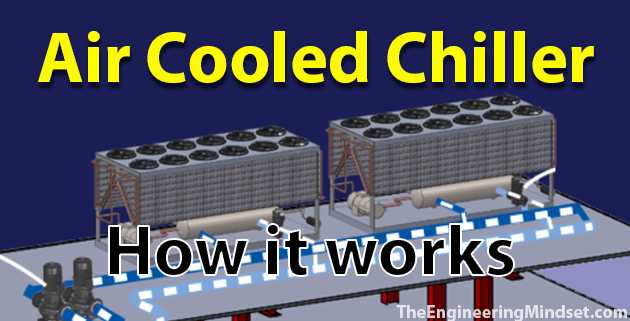
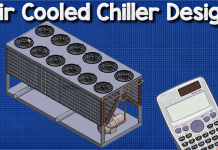
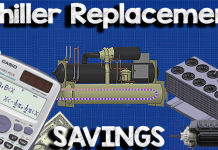
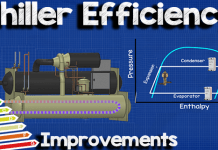

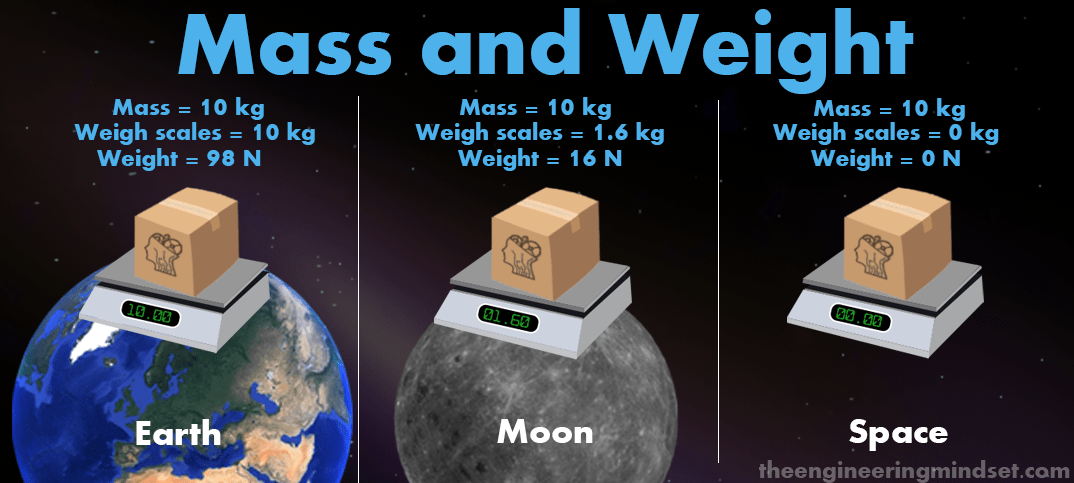
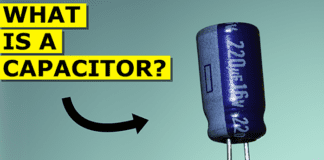

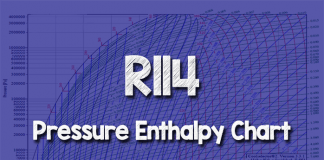
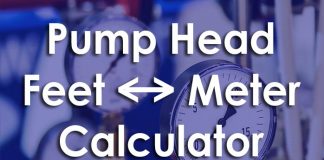
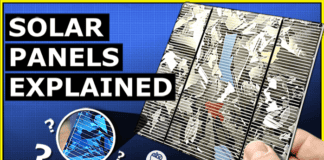







[…] you’re interested in the operation of chillers, then we’ve also covered how Air cooled chillers work here and we have plenty more videos on the subjects in our building services section of the […]
[…] Air cooled chillers will use fans to blow cool ambient air over their condenser to remove heat from the system, this type does not use a cooling tower. You can learn about this system and watch the video tutorial by clicking here. For the remainder of this article we will focus on water cooled chillers and cooling towers. […]
[…] are two main types of chillers, Air cooled and Water cooled. The term “Air” or “Water” cooled just tells the engineer […]
Why high pressure and temperature is required when refrigerant passes from compresser to condenser
[…] our previous Air Cooled Chiller tutorial (click here to see), we took a very basic look of how they work, this is a follow on to that, so if you haven’t […]
one of the best website for HVAC engineer. you simply explain how the air cooled chiller works. thanks
very useful content about air chiller. great video for air cooled chiller performance
Wow, thanks for posting such informative article. It really helped a lot understanding air cooled chillers work and it’s various 5 types. The video cleared all the remaining doubts. Great content and keep posting.
a couple things i would change in not just this article but all of them that is mis informative to the readers is, in all the articles on a/c, heatpumps,chillers, ect. it states that when the refrigerant leaves the condenser its in the saturated liquid state and when it leaves the evaporator its in the saturated vapor state. That information is actually incorrect. The word saturated in terms of refrigerant means that its in a state where both liquid and vapor refrigerant exist. So you will have a saturated vapor/liquid mixture coming out of your metering device feeding into your evaporator and a portion of your evaporator will have refrigerant in a saturated state, but by the time the refrigerant leaves the evaporator it must leave as a superheated vapor to avoid any liquid from making its way back to the compressor. And as with the refrigerant leaving the condenser, this refrigerant must be a subcooled liquid to avoid refrigerant flashing back off to a gas before it reaches the metering device. If it left the condenser as a saturated liquid as you call it, there would be no subcooling taking place in the condenser.
thank you very much. It was really helpfull.
This article was great, thank you for your effort
very helpful chiller. i am a HVAC expert and this article help me a lot. thanks for your perfect site.
very good article about air cooled chiller. thanks you